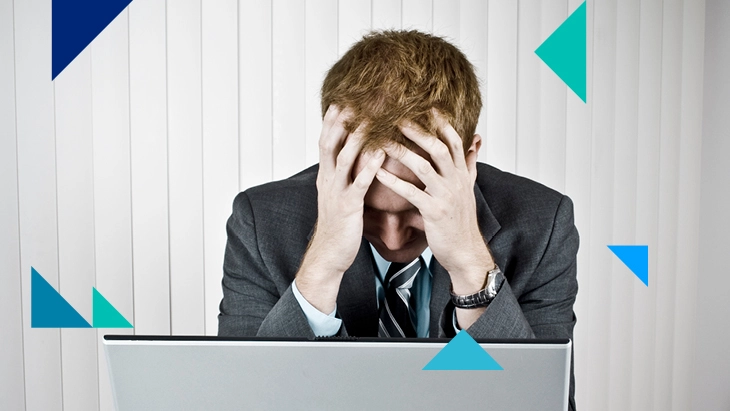Mental Health Awareness Week: Anxiety
6 min read | Hannah Pearsall | Article | Workplace | Wellbeing

Workplace anxiety. It’s something we’ve probably all dealt with before, but unfortunately for some of us, it happens more frequently than others. What might begin as a small worry over an upcoming deadline, a presentation, or a difficult conversation can easily spiral into something all-consuming, resulting in unpleasant side effects, both mental and physical.
Anxiety and stress are often used interchangeably and while they do share many symptoms, they are different. Stress is a physiological and behavioural response to a perceived threat or challenge, whereas anxiety is an emotional feeling and psychological state anticipating the possibility of harm.
But what actually causes anxiety, and how does this manifest at work? According to the NHS, when we are feeling scared or nervous, the body releases stress hormones, such as adrenaline and cortisol. This can be helpful in some situations, but in others, it can lead to an increased heart rate, sweating, headaches and stomach pain, plus racing thoughts, difficulty concentrating and more.
The triggers for anxiety are different for everyone, and the workplace is no exception. For some people, the idea of delivering a speech or webinar to a group of people will give them a feeling of exhilaration, whereas others will dread it, for example. Other situations are far less obvious: those who take pride in excellent time-management and organisation might feel anxiety or stress when their schedules are interrupted or when systems go down, and those who enjoy multi-tasking and working on a variety of projects might feel the same when they need to focus on one task only – especially when it’s time-sensitive. The extent to which we feel anxious varies in frequency, intensity and duration and it can be experienced through our thoughts, feelings and physical sensations. Anxiety can vary from mild feelings or uneasiness through to terrifying panic attacks. So anxiety is by no means a “one-size-fits-all” condition, and therefore there’s no single approach to tackle it that’ll help everyone who suffers. However, there are many resources available that individuals can use to alleviate some of the symptoms, and plenty that employers can offer their teams to support during challenging times.
Focusing on the facts
Anxiety is one of the most common mental health conditions our society faces at the moment. In fact, recent research from the Mental Health Foundation shows that over a quarter of adults say they’ve felt so anxious that it’s stopped them from doing things how they’ve wanted to either some of or all of the time. This can include carrying out their work responsibilities, or even being able to make it into work.
A study the Health and Safety Executive carried out in 2022 revealed that out of those people suffering from a work-related illness, 822,000 were affected by work-related stress, depression or anxiety. According to the government body, stress is thought to be responsible for around 50% of “lost” working days. In fact – work-related stress is the most common type, with 79% of people saying they felt it frequently. Whilst this year’s Mental Health Awareness theme is anxiety, it’s important that we work to mitigate the risk of all workplace mental health conditions, working to reduce this will not only have a beneficial impact on individuals, but organisations, too, as poor mental health is currently estimated by Deloitte to cost employers up to £56 billion per year.
What can employers do?
Helping staff towards better workplace wellness isn’t just the right thing to do, and nor is it simply a way of mitigating workplace absences, improving productivity, and increasing happiness of employees – although these are all genuine benefits of doing so. Employers have, by law, a duty of care they need to show their people – both physically and mentally – so it’s imperative that the right tools are in place to help.
It's important to provide staff with the ability to have open and honest conversations, ensuring they have a psychological safe space to discuss what they may be dealing with, without fear that it will negatively impact their careers. Consider putting in place regular check-ins with your team, if you aren’t already doing so, to see how they’re coping with their workload, professional relationships, and the office environment, for example. Remember, though, that everyone’s needs are different, so be prepared to treat each person’s situation as their own.
Organisations should also consider training volunteers to become mental-health first-aiders and ensuring that they have a good Employee Assistance Scheme in place, which can provide staff with health and wellbeing resources such as counselling, self-help modules and more.
Some excellent resources that we’d recommend both employees and employers to look at are those provided by organisations such as Mind and Anxiety UK. In addition to that, here at Hays we offer free courses via My Learning to help support individuals with their mental health, including sessions on tackling anxiety, building confidence, mindfulness, working on mindset and more. Within this brilliant tool are also courses that managers can take to learn how to help their teams, too.
About this author
Hannah Pearsall, Head of Wellbeing, Hays UK&I
Hannah has over 20 years of recruitment experience across a number of business areas, including construction and property, technology, engineering, energy, social care, human resources and procurement. She is now the Head of Wellbeing at Hays and leads on the design, development, implementation and delivery of a holistic and evolving wellbeing strategy for the UK and Ireland.
